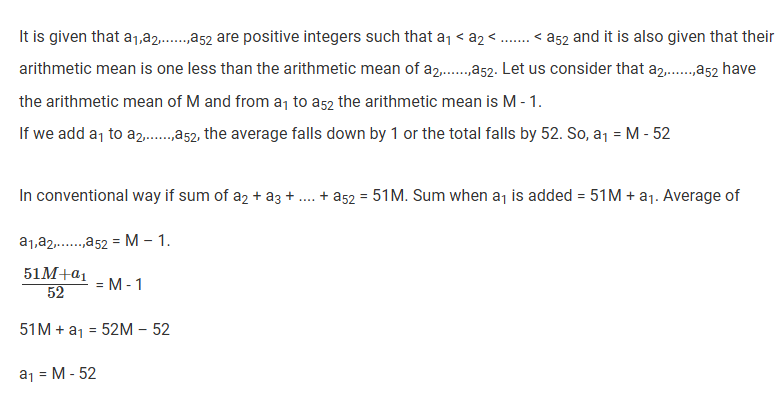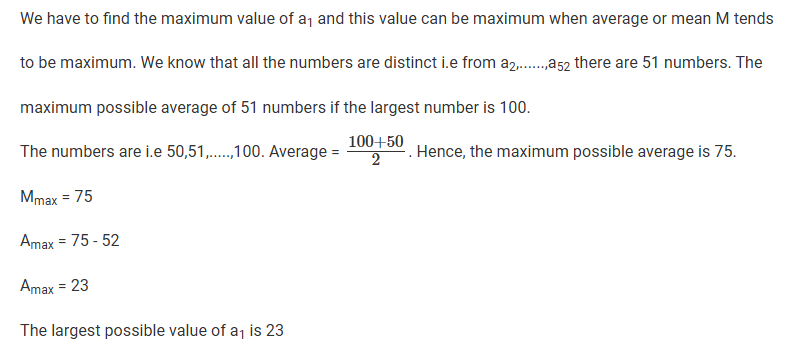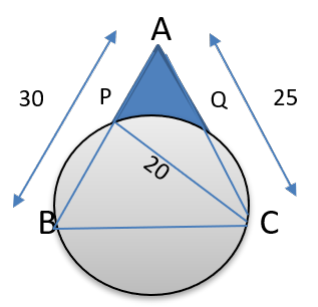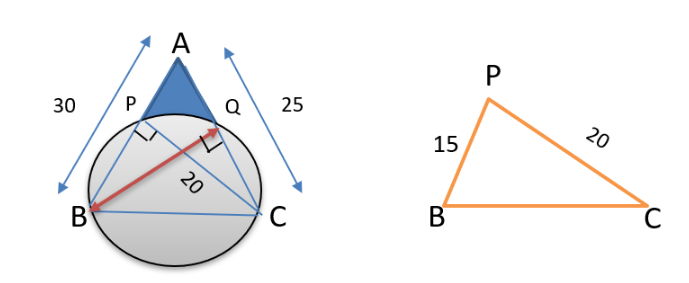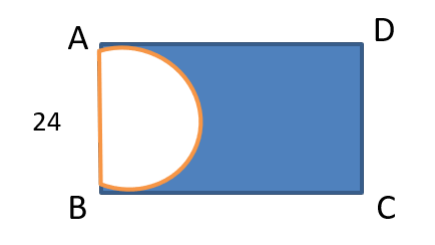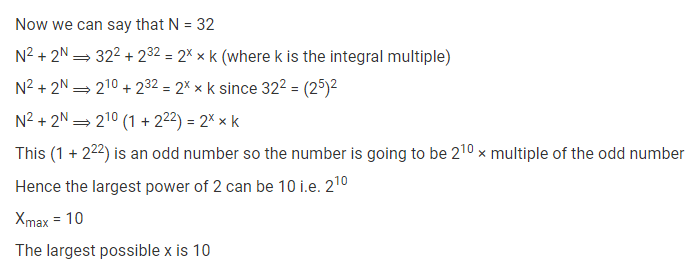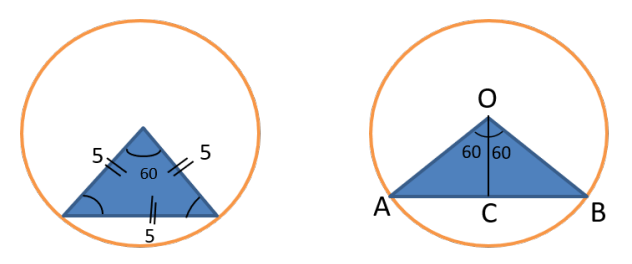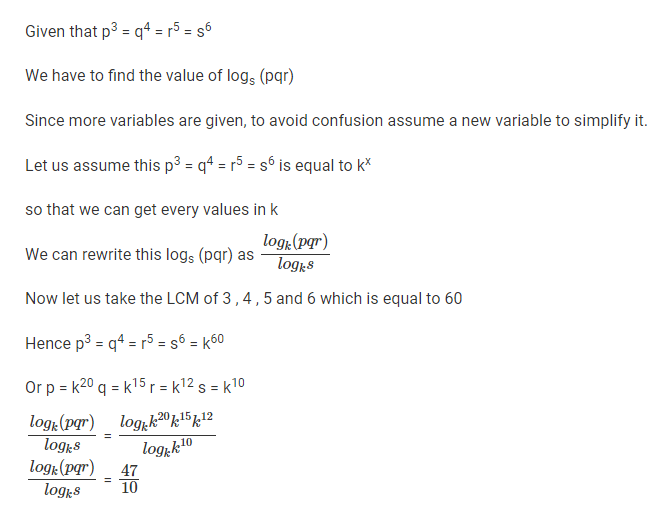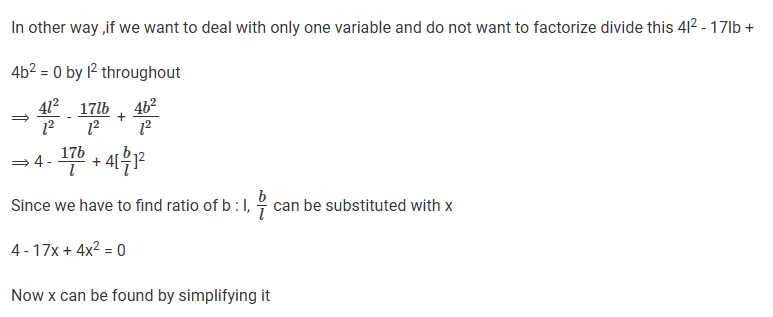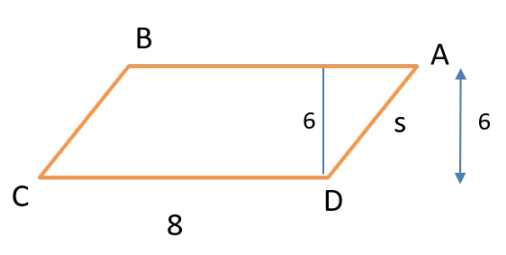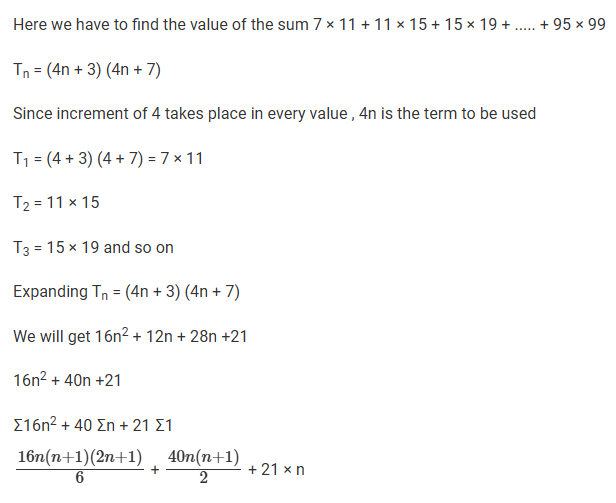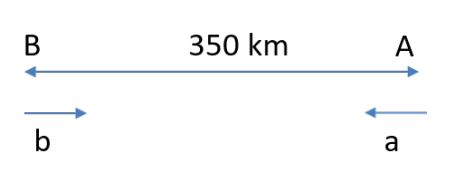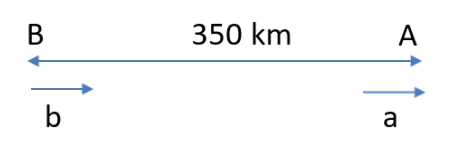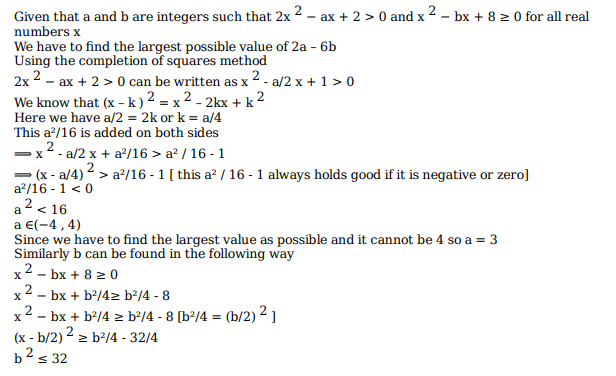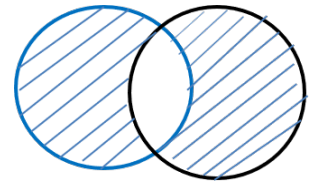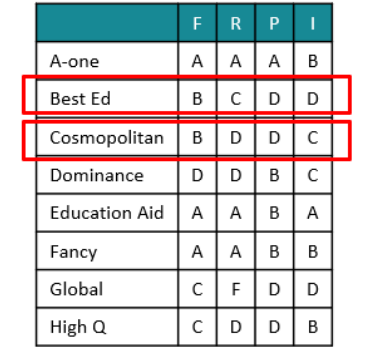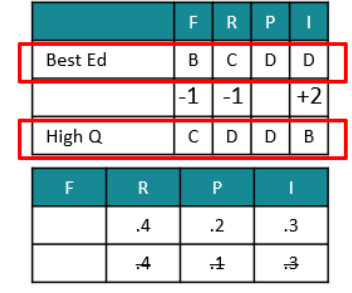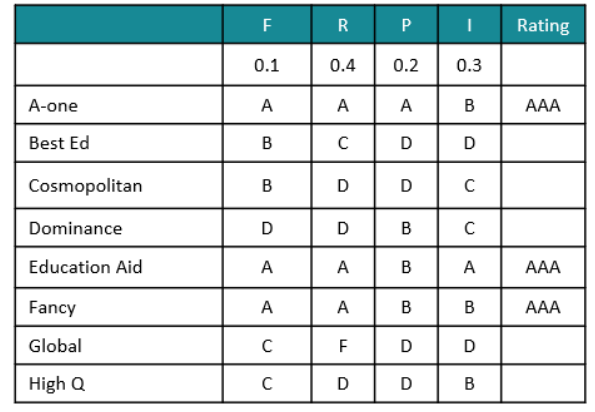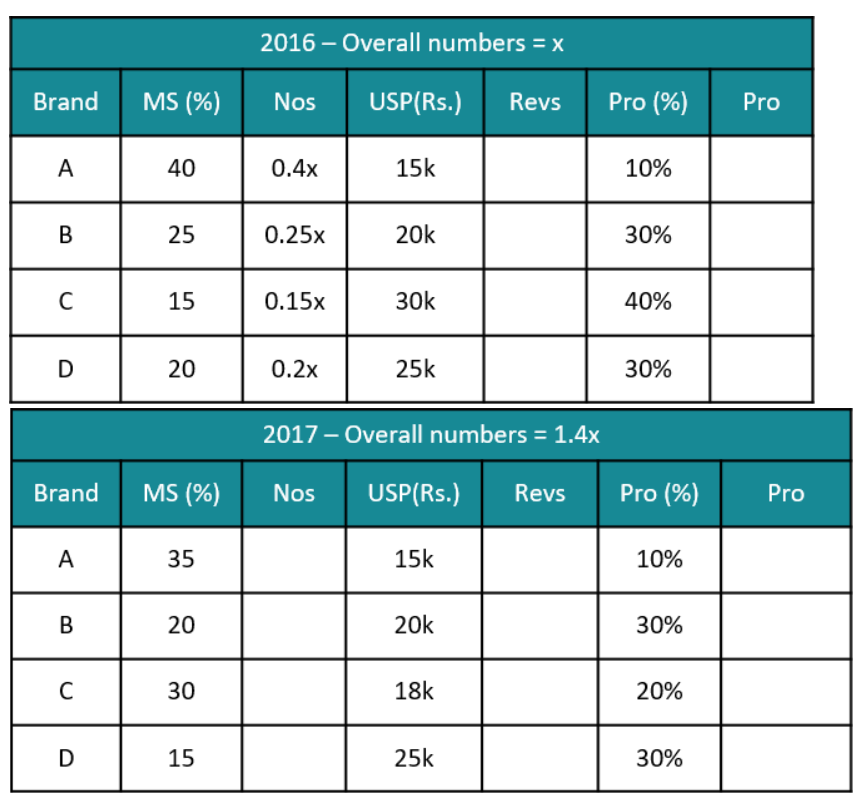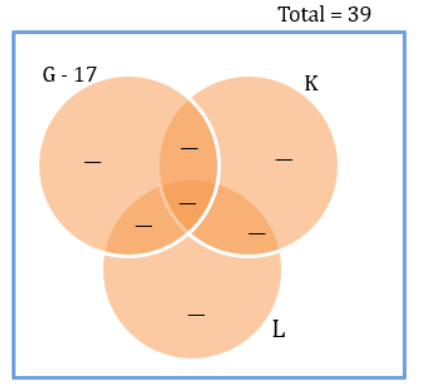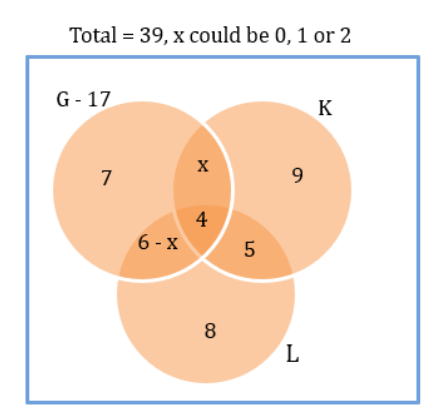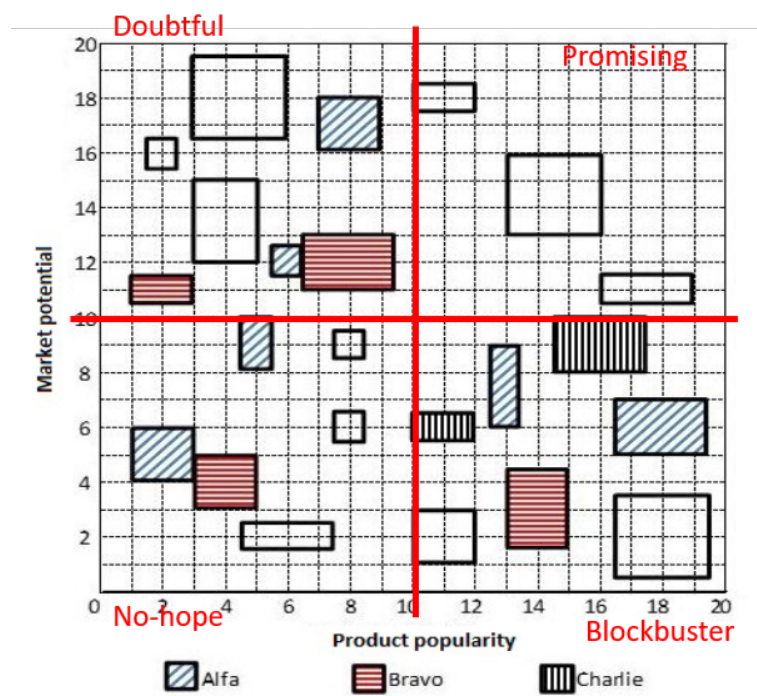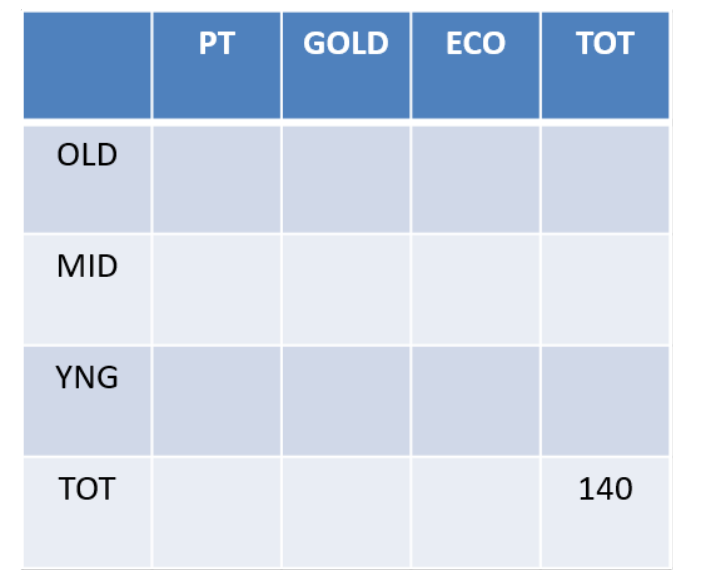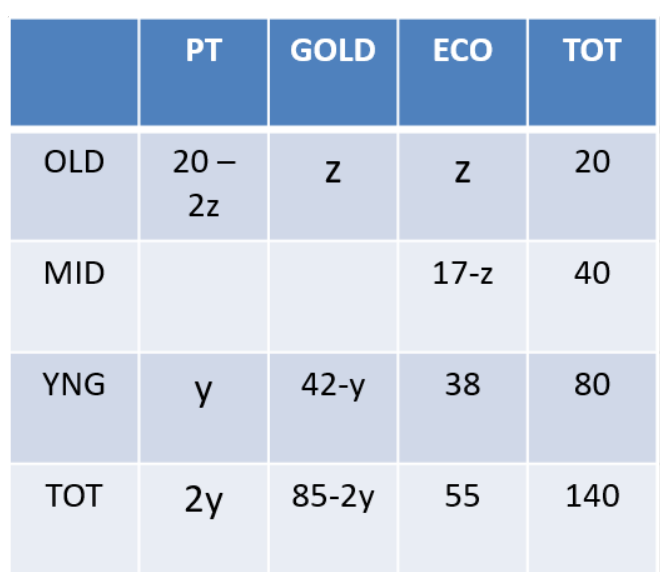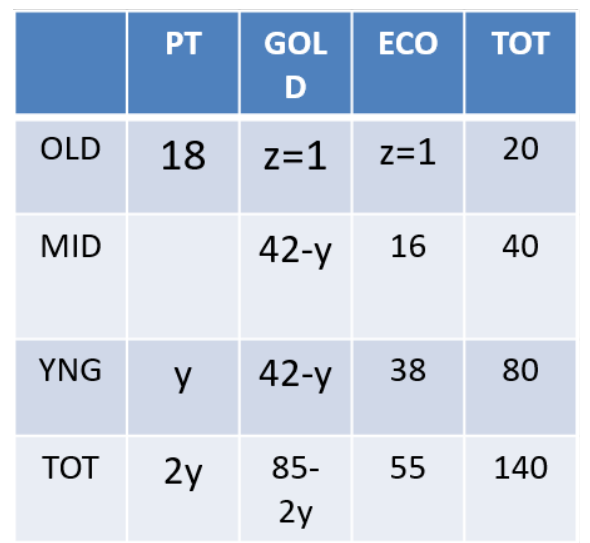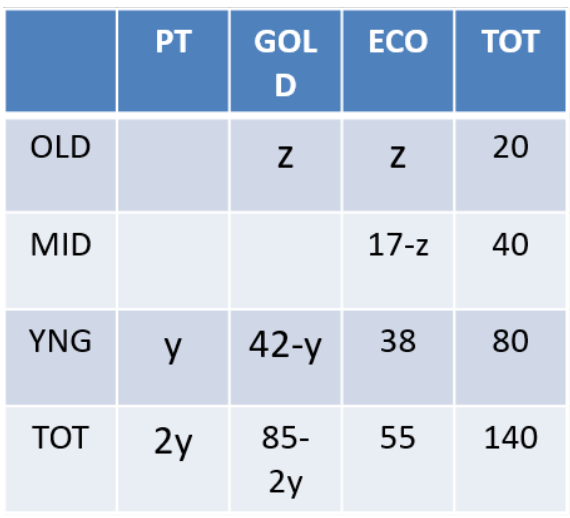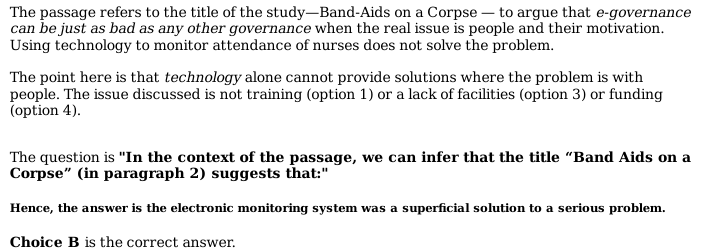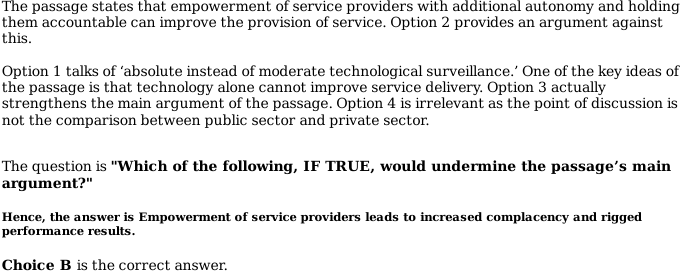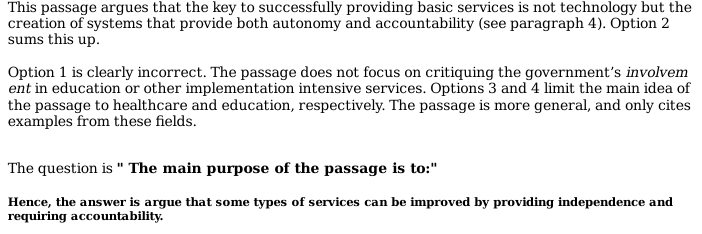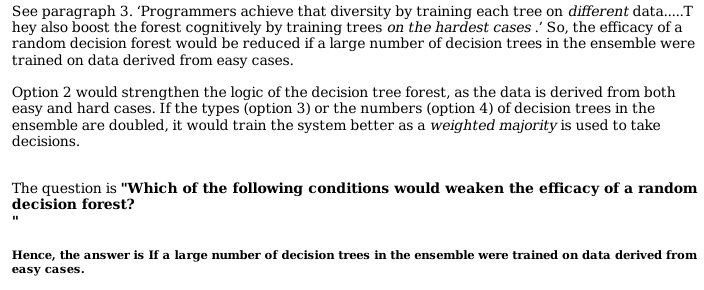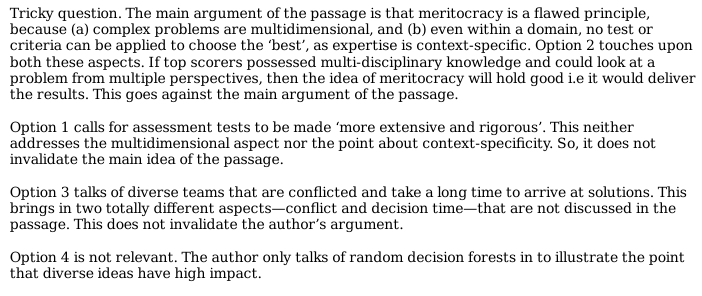Live Updates
• CATKing has launched new chat bot.

• New video on Logs has been released.
419
Learners
asked the doubt

Previous Year Questions
Points A, P, Q and B lie on the same line such that P, Q and B are, respectively, 100 km, 200 km and 300 km away from A. Cars 1 and 2 leave A at the same time and move towards B. Simultaneously, car 3 leaves B and moves towards A. Car 3 meets Car 1 at Q, and Car 2 at P. If each car is moving in uniform speed then the ratio of the speed of Car 2 to that of Car 1 is
Video Explanation

There are two drums, each containing a mixture of paints A and B. In drum 1, A and B are in the ratio 18 : 7. The mixtures from drums 1 and 2 are mixed in the ratio 3 : 4 and in this final mixture, A and B are in the ratio 13 : 7. In drum 2, then A and B were in the ratio
Video Explanation

Let t1, t2,… be real numbers such that t1+ t2 +. + tn = 2n2 + 9n + 13, for every positive integer n ≥ 2. If tk=103, then k equals
Video Explanation

From a rectangle ABCD of area 768 sq cm, a semicircular part with diameter AB and area 72π sq cm is removed. The perimeter of the leftover portion, in cm, is
Video Explanation

If N and x are positive integers such that NN = 2160 and N2 + 2N is an integral multiple of 2x, then the largest possible x is
Video Explanation

A chord of length 5 cm subtends an angle of 60° at the centre of a circle. The length, in cm, of a chord that subtends an angle of 120° at the centre of the same circle is
Video Explanation

If p3 = q4 = r5 = s6, then the value of logs (pqr) is equal to
Video Explanation

In a tournament, there are 43 junior level and 51 senior level participants. Each pair of juniors play one match. Each pair of seniors play one match. There is no junior versus senior match. The number of girl versus girl matches in junior level is 153, while the number of boy versus boy matches in senior level is 276. The number of matches a boy plays against a girl is
Video Explanation

A 20% ethanol solution is mixed with another ethanol solution, say, S of unknown concentration in the proportion 1:3 by volume. This mixture is then mixed with an equal volume of 20% ethanol solution. If the resultant mixture is a 31.25% ethanol solution, then the unknown concentration of S is
Video Explanation

The area of a rectangle and the square of its perimeter are in the ratio 1 : 25. Then the lengths of the shorter and longer sides of the rectangle are in the ratio
Video Explanation

The smallest integer n for which 4n > 1719 holds, is closest to
Video Explanation

The smallest integer n such that n3 - 11n2 + 32n - 28 > 0 is
Video Explanation

A parallelogram ABCD has area 48 sqcm. If the length of CD is 8 cm and that of AD is s cm, then which one of the following is necessarily true?
Video Explanation

The value of the sum 7 x 11 + 11 x 15 + 15 x 19 + . + 95 x 99 is
Video Explanation

On a long stretch of east-west road, A and B are two points such that B is 350 km west of A. One car starts from A and another from B at the same time. If they move towards each other, then they meet after 1 hour. If they both move towards east, then they meet in 7 hrs. The difference between their speeds, in km per hour, is
Video Explanation

If the sum of squares of two numbers is 97, then which one of the following cannot be their product?
Video Explanation

Points A and B are 150 km apart. Cars 1 and 2 travel from A to B, but car 2 starts from A when car 1 is already 20 km away from A. Each car travels at a speed of 100 kmph for the first 50 km, at 50 kmph for the next 50 km, and at 25 kmph for the last 50 km. The distance, in km, between car 2 and B when car 1 reaches B is
Video Explanation

A tank is emptied everyday at a fixed time point. Immediately thereafter, either pump A or pump B or both start working until the tank is full. On Monday, A alone completed filling the tank at 8 pm. On Tuesday, B alone completed filling the tank at 6 pm. On Wednesday, A alone worked till 5 pm, and then B worked alone from 5 pm to 7 pm, to fill the tank. At what time was the tank filled on Thursday if both pumps were used simultaneously all along?
Video Explanation

Ramesh and Ganesh can together complete a work in 16 days. After seven days of working together, Ramesh got sick and his efficiency fell by 30%. As a result, they completed the work in 17 days instead of 16 days. If Ganesh had worked alone after Ramesh got sick, in how many days would he have completed the remaining work?
Video Explanation

If a and b are integers such that 2x2 − ax + 2 > 0 and x2 − bx + 8 ≥ 0 for all real numbers x, then the largest possible value of 2a − 6b is
Video Explanation

A triangle ABC has area 32 sq units and its side BC, of length 8 units, lies on the line x = 4. Then the shortest possible distance between A and the point (0,0) is
Video Explanation

How many two-digit numbers, with a non-zero digit in the units place, are there which are more than thrice the number formed by interchanging the positions of its digits?
Video Explanation

Let f(x)=max{5x, 52 - 2x2}, where x is any positive real number.Then the minimum possible value of f(x) is
Video Explanation

If A = {62n - 35n - 1: n = 1,2,3,.} and B = {35(n-1) : n = 1,2,3,.} then which of the following is true?
Video Explanation

The strength of a salt solution is p% if 100 ml of the solution contains p grams of salt. If three salt solutions A, B, C are mixed in the proportion 1 : 2 : 3, then the resulting solution has strength 20%. If instead the proportion is 3 : 2 : 1, then the resulting solution has strength 30%. A fourth solution, D, is produced by mixing B and C in the ratio 2 : 7. The ratio of the strength of D to that of A is
Video Explanation

College Accreditation
An agency entrusted to accredit colleges looks at four parameters: faculty quality (F), reputation (R), placement quality (P), and infrastructure (I). The four parameters are used to arrive at an overall score, which the agency uses to give an accreditation to the colleges. In each parameter, there are five possible letter grades given, each carrying certain points: A (50 points), B (40 points), C (30 points), D (20 points), and F (0 points). The overall score for a college is the weighted sum of the points scored in the four parameters. The weights of the parameters are 0.1, 0.2, 0.3 and 0.4 in some order, but the order is not disclosed.
Accreditation is awarded based on the following scheme:

Eight colleges apply for accreditation, and receive the following grades in the four parameters (F, R, P, and I):

It is further known that in terms of overall scores:
1. High Q is better than Best Ed.
2. Best Ed is better than Cosmopolitan.
3. Education Aid is better than A-one.
What is the weight of the faculty quality parameter?
Video Explanation

How many colleges receive the accreditation of AAA? [TITA]
Video Explanation

What is the highest overall score among the eight colleges? [TITA]
Video Explanation

How many colleges have overall scores between 31 and 40, both inclusive?
Video Explanation

Smartphones
There are only four brands of entry level smartphones called Azra, Bysi, Cxqi, and Dipq in a country. Details about their market share, unit selling price, and profitability (defined as the profit as a percentage of the revenue) for the year 2016 are given in the table below:

In 2017, sales volume of entry level smartphones grew by 40% as compared to that in 2016. Cxqi offered a 40% discount on its unit selling price in 2017, which resulted in a 15% increase in its market share. Each of the other three brands lost 5% market share. However, the profitability of Cxqi came down to half of its value in 2016. The unit selling prices of the other three brands and their profitability values remained the same in 2017 as they were in 2016.
The brand that had the highest revenue in 2016 is:
Video Explanation

The complete list of brands whose profits went up in 2017 from 2016 is:
Video Explanation

Fun Sports Club
Fun Sports (FS) provides training in three sports - Gilli-danda (G), Kho-Kho (K), and Ludo (L). Currently it has an enrollment of 39 students each of whom is enrolled in at least one of the three sports. The following details are known:
1. The number of students enrolled only in L is double the number of students enrolled in all the three sports.
2. There are a total of 17 students enrolled in G.
3. The number of students enrolled only in G is one less than the number of students enrolled only in L.
4. The number of students enrolled only in K is equal to the number of students who are enrolled in both K and L.
5. The maximum student enrollment is in L.
6. Ten students enrolled in G are also enrolled in at least one more sport.
What is the minimum number of students enrolled in both G and L but not in K? [TITA]
Video Explanation

If the numbers of students enrolled in K and L are in the ratio 19:22, then what is the number of students enrolled in L?
Video Explanation

Due to academic pressure, students who were enrolled in all three sports were asked to withdraw from one of the three sports. After the withdrawal, the number of students enrolled in G was six less than the number of students enrolled in L, while the number of students enrolled in K went down by one.After the withdrawal, how many students were enrolled in both G and L?
Video Explanation

Products and Companies
Each of the 23 boxes in the picture below represents a product manufactured by one of the following three companies: Alfa, Bravo and Charlie. The area of a box is proportional to the revenue from the corresponding product, while its centre represents the Product popularity and Market potential scores of the product (out of 20). The shadings of some of the boxes have got erased.

The companies classified their products into four categories based on a combination of scores (out of 20) on the two parameters - Product popularity and Market potential as given below:

The following facts are known:
1. Alfa and Bravo had the same number of products in the Blockbuster category.
2. Charlie had more products than Bravo but fewer products than Alfa in the No-hope category.
3. Each company had an equal number of products in the Promising category.
4. Charlie did not have any product in the Doubtful category, while Alfa had one product more than Bravo in this category.
5. Bravo had a higher revenue than Alfa from products in the Doubtful category.
6. Charlie had a higher revenue than Bravo from products in the Blockbuster category.
7. Bravo and Charlie had the same revenue from products in the No-hope category.
8. Alfa and Charlie had the same total revenue considering all products.
Considering all companies products, which product category had the highest revenue?
Video Explanation

Which of the following is the correct sequence of numbers of products Bravo had in No-hope, Doubtful, Promising and Blockbuster categories respectively?
Video Explanation

If the smallest box on the grid is equivalent to revenue of Rs.1 crore, then what approximately was the total revenue of Bravo in Rs. crore?
Video Explanation

Amusement Park Tickets
Each visitor to an amusement park needs to buy a ticket. Tickets can be Platinum, Gold, or Economy. Visitors are classified as Old, Middle-aged, or Young. The following facts are known about visitors and ticket sales on a particular day:
1. 140 tickets were sold.
2. The number of Middle-aged visitors was twice the number of Old visitors, while the number of Young visitors was twice the number of Middle-aged visitors.
3. Young visitors bought 38 of the 55 Economy tickets that were sold, and they bought half the total number of Platinum tickets that were sold.
4. The number of Gold tickets bought by Old visitors was equal to the number of Economy tickets bought by Old visitors.
Job Interview
Seven candidates, Akil, Balaram, Chitra, Divya, Erina, Fatima, and Ganeshan, were invited to interview for a position. Candidates were required to reach the venue before 8 am. Immediately upon arrival, they were sent to one of three interview rooms: 101, 102, and 103. The following venue log shows the arrival times for these candidates. Some of the names have not been recorded in the log and have been marked as ‘?’.

Additionally here are some statements from the candidates:
Balaram: I was the third person to enter Room 101.
Chitra: I was the last person to enter the room I was allotted to.
Erina: I was the only person in the room I was allotted to.
Fatima: Three people including Akil were already in the room that I was allotted to when I entered it.
Ganeshan: I was one among the two candidates allotted to Room 102.
What best can be said about the room to which Divya was allotted?
Video Explanation

If Ganeshan entered the venue before Divya, when did Balaram enter the venue?
Video Explanation

Will a day come when India’s poor can access government services as easily as drawing cash from an ATM? No country in the world has made accessing education or health or policing or dispute resolution as easy as an ATM, because the nature of these activities requires individuals to use their discretion in a positive way. Technology can certainly facilitate this in a variety of ways if it is seen as one part of an overall approach, but the evidence so far in education, for instance, is that just adding computers alone doesn’t make education any better.
The dangerous illusion of technology is that it can create stronger, top down accountability of service providers in implementation-intensive services within existing public sector organisations. One notion is that electronic management information systems (EMIS) keep better track of inputs and those aspects of personnel that are ‘EMIS visible’ can lead to better services. A recent study examined attempts to increase attendance of Auxiliary Nurse Midwife (ANMs) at clinics in Rajasthan, which involved high-tech time clocks to monitor attendance. The study’s title says it all: Band-Aids on a Corpse. E-governance can be just as bad as any other governance when the real issue is people and their motivation.
For services to improve, the people providing the services have to want to do a better job with the skills they have. A study of medical care in Delhi found that even though providers, in the public sector had much better skills than private sector providers their provision of care in actual practice was much worse.
In implementation-intensive services the key to success is face-to-face interactions between a teacher, a nurse, a policeman, an extension agent and a citizen. This relationship is about power. Amartya Sen’s report on education in West Bengal had a supremely telling anecdote in which the villagers forced the teacher to attend school, but then, when the parents went off to work, the teacher did not teach, but forced the children to massage his feet. As long as the system empowers providers over citizens, technology is irrelevant.
The answer to successfully providing basic services is to create systems that provide both autonomy and accountability. In basic education for instance, the answer to poor teaching is not controlling teachers more. The key is to hire teachers who want to teach and let them teach, expressing their professionalism and vocation as a teacher through autonomy in the classroom. This autonomy has to be matched with accountability for results—not just narrowly measured through test scores, but broadly for the quality of the education they provide.
A recent study in Uttar Pradesh showed that if, somehow, all civil service teachers could be replaced with contract teachers, the state could save a billion dollars a year in revenue and double student learning. Just the additional autonomy and accountability of contracts through local groups—even without complementary system changes in information and empowerment—led to that much improvement. The first step to being part of the solution is to create performance information accessible to those outside of the government.
In the context of the passage, we can infer that the title “Band Aids on a Corpse” (in paragraph 2) suggests that:
Video Explanation

According to the author, service delivery in Indian education can be improved in all of the following ways EXCEPT through:
Video Explanation

Which of the following, IF TRUE, would undermine the passage’s main argument?
Video Explanation

The author questions the use of monitoring systems in services that involve face-to-face interaction between service providers and clients because such systems:
Video Explanation

Letter Codes
According to a coding scheme the sentence,
Peacock is designated as the national bird of India is coded as 5688999 35 1135556678 56 458 13666689 1334 79 13366
This coding scheme has the following rules:
1. The scheme is case-insensitive (does not distinguish between upper case and lower case letters).
2. Each letter has a unique code which is a single digit from among 1,2,3,......,9.
3. The digit 9 codes two letters, and every other digit codes three letters.
4. The code for a word is constructed by arranging the digits corresponding to its letters in a non-decreasing sequence.
Answer these questions on the basis of this information
What best can be concluded about the code for the letter L?
Video Explanation

What best can be concluded about the code for the letter B?
Video Explanation

For how many digits can the complete list of letters associated with that digit be identified?
Video Explanation

Which set of letters CANNOT be coded with the same digit?
Video Explanation

Currency Exchange
The base exchange rate of a currency X with respect to a currency Y is the number of units of currency Y which is equivalent in value to one unit of currency X. Currency exchange outlets buy currency at buying exchange rates that are lower than base exchange rates, and sell currency at selling exchange rates that are higher than base exchange rates.
A currency exchange outlet uses the local currency L to buy and sell three international currencies A, B, and C, but does not exchange one international currency directly with another. The base exchange rates of A, B and C with respect to L are in the ratio 100:120:1. The buying exchange rates of each of A, B, and C with respect to L are 5% below the corresponding base exchange rates, and their selling exchange rates are 10% above their corresponding base exchange rates.
The following facts are known about the outlet on a particular day:
1. The amount of L used by the outlet to buy C equals the amount of L it received by selling C.
2. The amounts of L used by the outlet to buy A and B are in the ratio 5:3.
3. The amounts of L the outlet received from the sales of A and B are in the ratio 5:9.
4. The outlet received 88000 units of L by selling A during the day.
5. The outlet started the day with some amount of L, 2500 units of A, 4800 units of B, and 48000 units of C.
6. The outlet ended the day with some amount of L, 3300 units of A, 4800 units of B,and 51000 units of C.
How many units of currency A did the outlet buy on that day? [TITA]
Video Explanation

How many units of currency C did the outlet sell on that day?
Video Explanation

What was the base exchange rate of currency B with respect to currency L on that day? [TITA]
Video Explanation

What was the buying exchange rate of currency C with respect to currency L on that day?
Video Explanation

Grove snails as a whole are distributed all over Europe, but a specific variety of the snail, with a distinctive white-lipped shell, is found exclusively in Ireland and in the Pyrenees mountains that lie on the border between France and Spain. The researchers sampled a total of 423 snail specimens from 36 sites distributed across Europe, with an emphasis on gathering large numbers of the white-lipped variety. When they sequenced genes from the mitochondrial DNA of each of these snails and used algorithms to analyze the genetic diversity between them, they found that a distinct lineage (the snails with the white-lipped shells) was indeed endemic to the two very specific and distant places in question.
Explaining this is tricky. Previously, some had speculated that the strange distributions of creatures such as the white-lipped grove snails could be explained by convergent evolution—in which two populations evolve the same trait by coincidence—but the underlying genetic similarities between the two groups rules that out. Alternately, some scientists had suggested that the white-lipped variety had simply spread over the whole continent, then been wiped out everywhere besides Ireland and the Pyrenees, but the researchers say their sampling and subsequent DNA analysis eliminate that possibility too.
“If the snails naturally colonized Ireland, you would expect to find some of the same genetic type in other areas of Europe, especially Britain. We just don’t find them,” Davidson, the lead author, said in a press statement.
Moreover, if they’d gradually spread across the continent, there would be some genetic variation within the white-lipped type, because evolution would introduce variety over the thousands of years it would have taken them to spread from the Pyrenees to Ireland. That variation doesn’t exist, at least in the genes sampled. This means that rather than the organism gradually expanding its range, large populations instead were somehow moved en mass to the other location within the space of a few dozen generations, ensuring a lack of genetic variety.
“There is a very clear pattern, which is difficult to explain except by involving humans,” Davidson said. Humans, after all, colonized Ireland roughly 9,000 years ago, and the oldest fossil evidence of grove snails in Ireland dates to roughly the same era. Additionally, there is archaeological evidence of early sea trade between the ancient peoples of Spain and Ireland via the Atlantic and even evidence that humans routinely ate these types of snails before the advent of agriculture, as their burnt shells have been found in Stone Age trash heaps.
The simplest explanation, then? Boats. These snails may have inadvertently traveled on the floor of the small, coast-hugging skiffs these early humans used for travel, or they may have been intentionally carried to Ireland by the seafarers as a food source. “The highways of the past were rivers and the ocean–as the river that flanks the Pyrenees was an ancient trade route to the Atlantic, what we’re actually seeing might be the long lasting legacy of snails that hitched a ride as humans travelled from the South of France to Ireland 8,000 years ago,” Davidson said.
All of the following evidence supports the passage’s explanation of sea travel/trade EXCEPT:
Video Explanation

The passage outlines several hypotheses and evidence related to white-lipped grove snails to arrive at the most convincing explanation for:
Video Explanation

Which one of the following makes the author eliminate convergent evolution as a probable explanation for why white-lipped grove snails are found in Ireland and the Pyrenees?
Video Explanation

In paragraph 4, the evidence that “humans routinely ate these types of snails before the advent of agriculture” can be used to conclude that:
Video Explanation

The complexity of modern problems often precludes any one person from fully understanding them. Factors contributing to rising obesity levels, for example, include transportation systems and infrastructure, media, convenience foods, changing social norms, human biology and psychological factors. The multidimensional or layered character of complex problems also undermines the principle of meritocracy: the idea that the ‘best person’ should be hired. There is no best person. When putting together an oncological research team, a biotech company such as Gilead or Genentech would not construct a multiple-choice test and hire the top scorers, or hire people whose resumes score highest according to some performance criteria. Instead, they would seek diversity. They would build a team of people who bring diverse knowledge bases, tools and analytic skills.
Believers in a meritocracy might grant that teams ought to be diverse but then argue that meritocratic principles should apply within each category. Thus the team should consist of the ‘best’ mathematicians, the ‘best’ oncologists, and the ‘best’ biostatisticians from within the pool. That position suffers from a similar flaw.
Even with a knowledge domain, no test or criteria applied to individuals will produce the best team. Each of these domains possesses such depth and breadth, that no test can exist. Consider the field of neuroscience. Upwards of 50,000 papers were published last year covering various techniques, domains of enquiry and levels of analysis, ranging from molecules and synapses up through networks of neurons. Given that complexity, any attempt to rank a collection of neuroscientists from best to worst, as if they were competitors in the 50-metre butterfly, must fail. What could be true is that given a specific task and the composition of a particular team, one scientist would be more likely to contribute than another. Optimal hiring depends on context. Optimal teams will be diverse.
Evidence for this claim can be seen in the way that papers and patents that combine diverse ideas tend to rank as high-impact. It can also be found in the structure of the so-called random decision forest, a state-of-the-art machine-learning algorithm.
Random forests consist of ensembles of decision trees. If classifying pictures, each tree makes a vote: is that a picture of a fox or a dog? A weighted majority rules. Random forests can serve many ends. They can identify bank fraud and diseases, recommend ceiling fans and predict online dating behaviour. When building a forest, you do not select the best trees as they tend to make similar classifications. You want diversity. Programmers achieve that diversity by training each tree on different data, a technique known as bagging. They also boost the forest ‘cognitively’ by training trees on the hardest cases – those that the current forest gets wrong. This ensures even more diversity and accurate forests."
Yet the fallacy of meritocracy persists. Corporations, non-profits, governments, universities and even preschools test, score and hire the ‘best’. This all but guarantees not creating the best team. Ranking people by common criteria produces homogeneity. That’s not likely to lead to breakthroughs.
The author critiques meritocracy for all the following reasons EXCEPT that:
Video Explanation

Which of the following conditions would weaken the efficacy of a random decision forest?
Video Explanation

Which of the following conditions, if true, would invalidate the passage’s main argument?
Video Explanation

On the basis of the passage, which of the following teams is likely to be most effective in solving the problem of rising obesity levels?
Video Explanation

Which of the following best describes the purpose of the example of neuroscience?
Video Explanation












